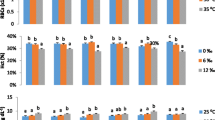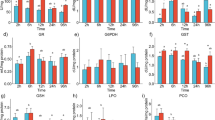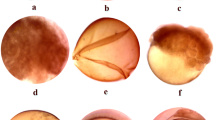Abstract
Experiencing the seasonal variation and rapid global warming in the tropical climate is a common phenomenon which challenged the aquatic organisms to adapt the physiology and behavior. To investigate the effect of high-temperature acclimation, we selected Indian major carp, rohu (Labeo rohita), a commercially important freshwater aquaculture species. Oxygen consumptions, micronucleus formation in erythrocytes, and gill histopathology were observed in L. rohita fingerlings acclimated at three temperatures (30, 33, and 36 °C) for 30 days. Results showed that the highest acclimated temperature (36 °C) induced higher oxygen consumption and increased frequency of micronucleus formation in erythrocytes. Severity of different histological alterations (hyperplasia, epithelial necrosis, telangiectasis, epithelial lifting, and hypertrophy of chloride cells) in the gills was found to be increased in the highest acclimated temperature (36 °C). These findings indicate the temperature induced adaptive responses and climate vulnerability in a changing environment.



Similar content being viewed by others
References
Angilletta MJ Jr (2009) Thermal adaptation: a theoretical and empirical synthesis. Oxford University Press, Oxford
Ashaf-Ud-Doulah M, Shahjahan M, Islam SMM, Al-Emran M, Rahman MS, Hossain MAR (2019) Thermal stress causes nuclear and cellular abnormalities of peripheral erythrocytes in Indian major carp, rohu Labeo rohita. J Therm Biol 86:102450
Ashaf-Ud-Doulah M, Mamun AA, Rahman ML, Islam SMM, Jannat R, Hossain MAR, Shahjahan M (2020) High temperature acclimation alters upper thermal limits and growth performance of Indian major carp, rohu, Labeo rohita (Hamilton, 1822). J Therm Biol 93:102738
Avrova NF (1999) Biochemical mechanisms of adaptation to changing conditions of environment in vertebrates, role of lipids. Z Evolyutsionnoi Biokhimii Fiziologii 35:170–180
Barnes KR, Cozzi RRF, Robertson G, Marshall WS (2014) Cold acclimation of NaCl secretion in a eurythermic teleost: mitochondrial function and gill remodeling. Comp Biochem Physiol Part A 168:50–62
Bowden AJ, Gardiner NM, Couturier CS, Stecyk JAW, Nilsson GE, Munday PL, Rummer JL (2014) Alterations in gill structure in tropical reef fishes as a results of elevated temperatures. Comp Biochem Physiol Part A 175:64–71
Brahmane MP, Krishnani KK, Sarkar B, Sajjanar B, Kumar S, Nakhawa AD, Minhas PS (2014) Growth, thermal tolerance and oxygen consumption in rohu, Labeo rohita early fry acclimated to four temperatures. African J Agril Res 9(9):854–858
Brauner C, Matey V, Zhang W, Richards J, Dhillon R, Cao ZD, Wang YX, Fu SJ (2011) Gill remodeling in crucian carp during sustained exercise and the effect on subsequent swimming performance. Physiol Biochem Zool 84:535–542
Burton T, Killen SS, Armstrong JD, Metcalfe NB (2011) What causes intraspecific variation in resting metabolic rate and what are its ecological consequences? Proc R Soc Lond B Biol Sci 278:3465–3473
Cataldi E, Di Marco P, Mandich A, Cataudella S (1998) Serum parameters of Adriatic sturgeon Acipenser naccarii (Pisces: Acipenseriformes): effects of temperature and stress. Comp Biochem Physiol 120:273–278
Chadwick JG, Nislow KH, McCormick SD (2015) Thermal onset of cellular and endocrine stress responses correspond to ecological limits in brook trout, an iconic cold-water fish. Conserv Physiol 3:cov017
Chatterjee N, Pal AK, Manush SM, Das T, Mukherjee SC (2004) Thermal tolerance and oxygen consumption of Labeo rohita and Cyprinus carpio early fingerlings acclimated to three different temperatures. J Therm Biol 29(6):265–270
Chen B, Fu S, Cao Z, Wang Y (2019) Effect of temperature on critical oxygen tension (Pcrit) and gill morphology in six cyprinids in the Yangtze River, China. Aquaculture 508:137–146
Christensen EAF, Svendsen MBS, Steffensen JF (2017) Plasma osmolality and oxygen consumption of perch Perca fluviatilis in response to different salinities and temperatures. J Fish Biol 90:819–833
Dabruzzi TF, Bennett WA (2014) Hypoxia effects on gill surface area and blood oxygen-carrying capacity of the Atlantic stingray, Dasyatis sabina. Fish Physiol Biochem 40:1011–1020
Das T, Pal AK, Chakraborty SK, Manush SM, Chatterjee N, Mukherjee SC (2004) Thermal tolerance and oxygen consumption of Indian major carps acclimated to four different temperatures. J Therm Biol 23:157–163
Das T, Pal AK, Chakraborty SK, Manush SM, Sahu NP, Mukherjee SC (2005) Thermal tolerance, growth and oxygen consumption of Labeo rohita fry (Hamilton, 1822) acclimated to four temperatures. J Therm Biol 30:378–383
Diaz RJ, Breitburg DL (2009) The hypoxic environment. In: Richards JG, Farrell AP, Brauner CJ (eds) Fish physiology: hypoxia, vol 27. Elsevier, Amsterdam, pp 1–23
Evans DH, Piermarini PM, Choe KP (2005) The multifunctional fish gill: dominant site of gas exchange, osmoregulation, acid-base regulation, and excretion of nitrogenous waste. Physiol Rev 85:97–177
Fenech M, Chang WP, Kirsch-Volders M, Holland N, Bonassi S, Zeiger E (2003) Human micronucleus project. HUMN project: detailed description of the scoring criteria for the cytokinesis-block micronucleus assay using isolated human lymphocyte cultures. Mutat Res 534:65–75
Fu KK, Fu C, Qin YL, Bai Y, Fu SJ (2018) The thermal acclimation rate varied among physiological functions and temperature regimes in a common cyprinid fish. Aquaculture 495:393–301
Ghaffar A, Riaz H, Ahrar K, Abbas RZ (2015) Hemato-biochemical and genetic damage caused by triazophos in freshwater fish Labeo rohita. Int J Agril Biol 17:637–642
Hazel JR (1984) Effects of temperature on the structure and metabolism of cell membranes in fish. Am J Physiol Regul Integr Comp Physiol 246:R460–R470
Hazel JR, Prosser CL (1974) Molecular mechanisms of temperature compensations in poikilotherms. Physiol Rev 54:620–677
He Y, Wu X, Zhu Y, Li H, Li X, Yang D (2014) Effect of rearing temperature on growth and thermal tolerance of Schizothorax (Racoma) kozlovi larvae and juveniles. J Therm Biol 46:24–30
Islam MA, Uddin MH, Uddin MJ, Shahjahan M (2019) Temperature changes influenced the growth performance and physiological functions of Thai pangas Pangasianodon hypophthalmus. Aquaculture Reports 13:100179
Islam SMM, Zahangir MU, Jannat R, Hasan MN, Suchana SA, Rohani MF, Shahjahan M (2020) Hypoxia reduced upper thermal limits causing cellular and nuclear abnormalities of erythrocytes in Nile tilapia Oreochromis niloticus. J Therm Biol 90:102604
Jahan A, Nipa TT, Islam SMM, Uddin MH, Islam MS, Shahjahan M (2019) Striped catfish (Pangasianodon hypophthalmus) could be suitable for coastal aquaculture. J Applied Ichthyol 35:994–1003
Johansson D, Ruohonen K, Kiessling A, Oppedal F, Stiansen J, Kelly M, Juell J (2006) Effect of environmental factors on swimming depth preferences of Atlantic salmon (Salmo salar L.) and temporal and spatial variations in oxygen levels in sea cages at a fjord site. Aquaculture 254:594–605
Kita J, Tsuchida S, Setoguma T (1996) Temperature preference and tolerance, and oxygen consumption of the marbled rock-¢sh, Sebasticus marmoratus. Mar Biol 125:467–471
Kreps EM (1981) Lipidy kletochnykh membran. Evolutsiya lipidov mozga. Adapattsionnaya funktsiya lipidov (lipids of cellular membranes. Evolution of Brain Lipids. Adaptive Function of Lipids). Nauk. Leningr. 339
Lu CY, Hsu CY (2015) Ambient temperature reduction extends lifespan via activating cellular degradation activity in an annual fish (Nothobranchius rachovii). Age (Dordr) 37:33
Madeira D, Narciso L, Cabral HN, Vinagre C (2012) Thermal tolerance and potential impacts of climate change on coastal and estuarine organisms. J Sea Res 70:32–41
Mishra AK, Mohanty B (2008) Acute toxicity impacts of hexavalent chromium on behavior and histopathology of gill, kidney and liver of the 422 freshwater fish, Channa punctatus (Bloch). Environ Toxicol Pharmcol 26:136–141
Mitrovic D, Dymowska A, Nilsson GE, Perry SF (2009) Physiological consequences of gill remodeling in goldfish (Carassius auratus) during exposure to long-term hypoxia. Am J Physiol Regul Integr Comp Physiol 297:R224–R234
Nilsson GE, Crawley N, Lunde IG, Munday PL (2009) Elevated temperature reduces the respiratory scope of coral reef fishes. Glob Chang Biol 15:1405–1412
Nilsson GE, Dymowska A, Stecyk JAW (2012) New insights into the plasticity of gill structure. Respir Physiol Neurobiol 184:214–222
Norin T, Malte H, Clark TD (2014) Aerobic scope does not predict the performance of a tropical eurythermal fish at elevated temperatures. J Exp Biol 217:244–251
Ong K, Stevens E, Wright P (2007) Gill morphology of the mangrove killifish (Kryptolebias marmoratus) is plastic and changes in response to terrestrial air exposure. J Exp Biol 210:1109–1115
Phuong ML, Huong DTT, Nyengaard JR, Bayley M (2017) Gill remodelling and growth rate of striped catfish Pangasianodon hypophthalmus under impacts of hypoxia and temperature. Comp Biochem Physiol Part A 203:288–296
Pörtner HO, Farrell AP (2008) Ecology. Physiol Climate Change Sci 322:690–692
Roessig JM, Woodley CM, Cech JJ, Hansen LJ (2004) Effects of global climate change on marine and estuarine fishes and fisheries. Rev Fish Biol Fish 14:251–275
Rombough ET, Garside ET (1977) Hypoxial death inferred from thermally induced injuries at upper lethal temperatures, in the banded killifish, Fundulus diaphanus (Le Sueur). Can J Zool 55:1705–1719
Royas LM, Mata C, Oliveros A, Salazar-Lugo R (2013) Histología de branquias, hígado y riñón de juveniles del pez neotropical Colossoma macropomum (Characiformes, Characidae) expuesto a tres temperaturas. Rev Biol Trop (Int J Trop Biol) 61:797–806
Sadiqul IM, Ferdousa Z, Nannu MTA, Mostakim GM, Rahman MK (2016) Acute exposure to a quinalphos containing insecticide (convoy) causes genetic damage and nuclear changes in peripheral erythrocytes of silver barb, Barbonymus gonionotus. Environ Pollut 219:949–956
Salam MA, Shahjahan M, Sharmin S, Haque F, Rahman MK (2015) Effects of sub-lethal doses of an organophosphorus insecticide sumithion on some hematological parameters in common carp, Cyprinus carpio. Pakistan J Zool 47:1487–1491
Sandersfeld T, Davison W, Lamare MD, Knust R, Richter C (2015) Elevated temperature causes metabolic trade-offs at the whole organism level in the Antarctic fish Trematomus bernacchii. J Exp Biol 218:2373–2381
Shahjahan M, Uddin MH, Bain V, Haque MM (2018) Increased water temperature altered hemato-biochemical parameters and structure of peripheral erythrocytes in striped catfish Pangasianodon hypophthalmus. Fish Physiol Biochem 44:1309–1318
Shahjahan M, Rahman MS, Islam SMM, Uddin MH, Al-Emran M (2019) Increase in water temperature increases acute toxicity of sumithion causing nuclear and cellular abnormalities in peripheral erythrocytes of zebrafish Danio rerio. Environ. Sci. Pollut Res 26:36903–36912
Shahjahan M, Khatun MS, Mun MM, Islam SMM, Uddin MH, Badruzzaman M, Khan MS (2020) Nuclear and cellular abnormalities of erythrocytes in response to thermal stress in common carp Cyprinus carpio. Front Physiol 11:543
Soivio A, Tuurala H (1981) Structural and circulatory responses to hypoxia in the secondary lamellae of Salmo gairdneri gills at two temperatures. Comp Biochem Physiol A 145:37–43
Sollid J, Nilsson GE (2006) Plasticity of respiratory structures — adaptive remodeling of fish gills induced by ambient oxygen and temperature. Respir Physiol Neurobiol 154:241–251
Sollid J, De Angelis P, Gundersen K, Nilsson GE (2003) Hypoxia induces adaptive and reversible gross morphological changes in crucian carp gills. J Exp Biol 206:3667–3673
Sollid J, Weber RE, Nilsson GE (2005) Temperature alters the respiratory surface area of crucian carp Carassius carassius and goldfish Carassius auratus. J Exp Biol 208:1109–1116
Takata R, Nakayama CL, Silva WS, Bazzoli N, Luz RK (2018) The effect of water temperature on muscle cellularity and gill tissue of larval and juvenile Lophiosilurus alexandri, a Neotropical freshwater fish. J Therm Biol 76:80–88
Talwar PK, Jhingran AG (1991) Inland fishes of India and adjacent countries. Oxford-IBH Publishing Co. Pvt. Ltd., New Delhi 1158 Pp
Tewksbury JJ, Huey RB, Deutsch CA (2008) Putting the heat on tropical animals. Science 320:1296–1297
Timmerman CM, Chapman LJ (2004) Behavioral and physiological compensation for chronic hypoxia in the sailfin molly (Poecilia latipinna). Physiol Biochem Zool 77:601–610
Todgham AE, Crombie TA, Hofmann GE (2017) The effect of temperature adaptation on the ubiquitin–proteasome pathway in notothenioid fishes. J Exp Biol 220:369–378
Wilson R, Taylor E (1993) The physiological responses of freshwater rainbow trout, Oncorhynchus mykiss, during acutely lethal copper exposure. J Comp Physiol B 163(1):38–47
Acknowledgments
This study was supported by a grant (2017/503/MoE) from the Ministry of Education of the People’s Republic of Bangladesh to the corresponding author which is gratefully acknowledged.
Author information
Authors and Affiliations
Corresponding author
Ethics declarations
The Animal Welfare and Ethical Committee, Bangladesh Agricultural University, approved the experimental procedures used in this study.
Competing interests
The authors declare that they have no conflicts of interest.
Additional information
Publisher’s note
Springer Nature remains neutral with regard to jurisdictional claims in published maps and institutional affiliations.
Rights and permissions
About this article
Cite this article
Islam, S.M.M., Zahangir, M.M., Ashaf-Ud-Doulah, M. et al. Extreme warm acclimation temperature alters oxygen consumption, micronucleus formation in erythrocytes, and gill morphology of rohu (Labeo rohita) fingerlings. Fish Physiol Biochem 46, 2323–2330 (2020). https://doi.org/10.1007/s10695-020-00886-6
Received:
Accepted:
Published:
Issue Date:
DOI: https://doi.org/10.1007/s10695-020-00886-6




